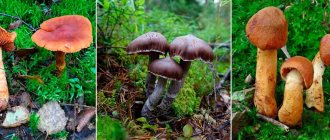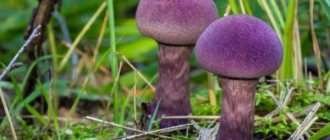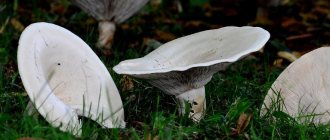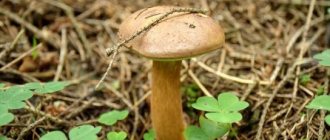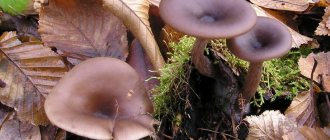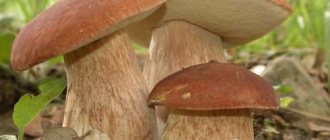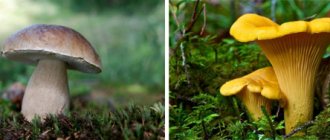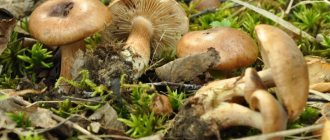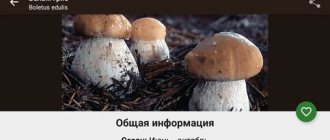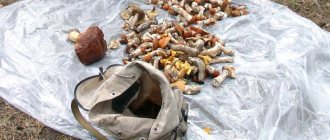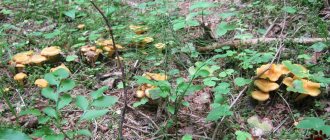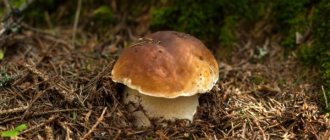Knowledge about edible mushrooms will be useful to every mushroom picker. Edible mushrooms include those mushrooms that are safe to eat and do not require special preparation. Edible mushrooms are divided into several types, the most famous of them: tubular, lamellar and marsupial. You can read more about edible mushrooms in this article.
What groups are types of mushrooms divided into?
These are edible, conditionally edible mushrooms, as well as those that cannot be consumed, hallucinogenic and poisonous. All species have the same type of nutrition. This is how this genus is united together. They feed osmotrophically. Fungi do not obtain useful components through photosynthesis, which is used exclusively by plants of higher groups. Fungi simply suck nutrients from the roots of trees, grasses, and shrubs.
Judging by the types of mushrooms in the photo, you can understand that these are not parasites at all. Many of their varieties are valued more than gold. For example, truffles. The spore-bearing layers of fungi are arranged differently.
Based on this difference, the following types are distinguished:
- Smooth.
- Folded.
- Spiky.
- Labyrinth-shaped.
- Polypores.
- Lamellar.
By the way, the types of lamellar mushrooms are all types of champignons and oyster mushrooms. They can be grown artificially, yielding rich harvests. It is better to place myceliums in a dark basement, regularly saturating them with moisture.
Mokhoviki
Next on the list are fly mushrooms and their varieties - for example, a mushroom called goat mushroom. As the name suggests, they prefer marshy areas with lots of moss. The peculiarity of this mushroom is that when cut, its pulp at the cut site immediately begins to turn blue. In addition, moss fly has a very pleasant smell.
This mushroom is good fried, dried and pickled. You can also salt it.
wikipedia.org / Ron Pastorino / CC BY-SA 3.0
Fungi families
When talking about what types of mushrooms there are, it is worth paying attention to entire families. They grow in different regions: some more in the south, others in Siberia, but they are all united by common characteristics.
This is how mycologists distinguish families:
- Champignonovykh,
- Fly agaric (pale toadstool, fly agaric),
- Morchkovs,
- Boletovs,
- Lisichkovs,
- Ryadkov,
- Negniuchnikovs,
- Stropharievs,
- Fisalakrievs,
- Syroezhkov.
Butter
Another mushroom with an excellent smell was the butterdish. It got its name because of its oily, slippery-to-the-touch cap, to which small leaves and Christmas tree needles often stick. In most cases, on its leg there is a characteristic ring, which is called the “veil”.
Butter can also be fried, dried, pickled and salted. They are in no way inferior in taste to moss mushrooms.
wikipedia.org/vesna maric (kalipso)/CC BY-SA 3.0
Edible varieties
There are many types of edible mushrooms, but it is worth remembering: even an edible mushroom, but grown in an environmentally unsafe area, can be poisonous.
The fact is that mushrooms, like sponges, absorb chemicals released into the air by enterprises, as well as moisture saturated with wastewater.
Among the main edible mushrooms:
- Chanterelles. They are bright, orange or rich yellow. There is also a white color. This type of mushroom, like chanterelle, is very common not only in central Russia, but also in almost all regions of the country. There are especially many of them in the Yakut taiga.
- Porcini. Rare and very valuable. A large hat is placed on a massive almost white stem. Its color can vary from dark brown to light cream. Boletus, as it is also called by lovers of quiet hunting, is divided into pine, spruce, and oak, depending on what trees it grows under.
- Butter. These mushrooms are also easy to confuse with inedible ones. They come with gray, red, yellowish, brown flat caps and slimy skin. With specks or grains, short or longer legs. They grow in sandstones.
- Volnushki. They can be easily identified by the dent in the central part of the cap. By the way, the caps of the wavefish are quite large in diameter. If you break the mushroom a little, you can feel a pleasant sweetish aroma. Volnushki grow mainly in open spaces.
- Oyster mushrooms. Can be seen on trees. They are grown artificially. A very tasty and absolutely safe mushroom.
- Honey mushrooms. They grow in large groups next to or directly on tree trunks, around stumps. The color is cream or light brown. It depends on the region. You can distinguish edible honey mushrooms by the ring on the stem. The false honey agaric does not have it.
- Saffron milk caps. The name speaks for itself. These types of mushrooms grow in coniferous forests. They can be distinguished by their concave, almost funnel-shaped cap, dense cylindrical stem and bright red color.
- Boletuses. These mushrooms are distinguished by a yellowish or creamy cap and a massive stem. They grow in deciduous forests and can be found closer to the trunks of aspen trees.
White boletus, boletus, boletus
The three main mushrooms are white (sometimes called boletus), boletus (red, or red-headed) and boletus. The first, as usual, grows in spruce undergrowth, and the second and third - in aspen or birch trees, as follows from their name.
Nevskie News / Sergey Pavlov
These mushrooms are believed to have the most nutritional benefits. In addition, they are considered the most delicious. Experienced lovers of collecting forest gifts usually look only for them, skipping all other mushrooms. However, one can argue with this approach.
Nevskie News / Sergey Pavlov
White boletus, boletus and boletus are best fried or pickled. You can dry them for the winter and then cook soup. For drying, they usually use the oven, placing mushrooms cut into pieces on a wire rack covered with food foil. Someone simply strings them on threads, tying matches without heads to the ends of the threads, and hangs them on the heater.
Pr Scr vk.com/grib_spb /
Conditionally edible
These are milk mushrooms, green mushrooms, morels, some types of truffles, and russula. The basic rule when collecting mushrooms of any type is that when in doubt whether to take it or not, you should thoroughly study the information about the mushroom and then make a decision. If there is the slightest doubt, it is better to leave such prey in the forest.
Some hunters are guided by the marks of the teeth of animals (squirrels, hares), which they leave on the caps of mushrooms or the degree of worminess. But this is not an indicator now either.
Tips for inexperienced mushroom pickers
To prevent the consumption of collected mushrooms from turning into a tragedy, experts advise adhering to the following recommendations:
- Research some of the most common edible species native to your area. It is advisable to first examine the real mushroom in person, and not in a picture or on a monitor. In the forest, choose mushrooms that have the characteristic features of these varieties.
- Do not take those copies, upon examination of which even the slightest doubt arises.
- Until you have enough experience, collect tubular mushrooms: boletus, boletus, boletus, boletus. Unlike lamellar mushrooms, they have few doubles.
- Do not try raw mushrooms: their taste will not give any information, but the slightest piece of a poisonous specimen is enough to cause poisoning.
- In the discovered family, first take a closer look at the large specimens: they have clearly defined characteristics and it will be easier to determine the species.
Some amateurs mistakenly believe that prolonged boiling with several changes of water allows you to remove toxins from the pulp of mushrooms and thus protect yourself. But the most dangerous poisons are surprisingly heat-resistant, so poisoning cannot be avoided when consuming mushrooms containing them.
All experienced mushroom pickers prefer to put in the basket only those species whose edibility there is not the slightest doubt. If you don’t have confidence in your own knowledge, it is better, after a successful “hunt” for forest gifts, to consult with experts rather than risk your own health and sometimes life.
Inedible mushrooms
Types of inedible mushrooms, of course, are not eaten, but not all of them are so poisonous. Some simply pose a digestive hazard or have poor taste, while others are toxic and deadly.
You should avoid pale toadstools (not only they themselves, but also their mycelia are highly poisonous), red fly agarics and satanic fly agarics.
By the way, all inedible mushrooms have edible counterparts. Many of the inedible mushrooms are unattractive in appearance. Therefore, everything brought from the forest must be carefully inspected.
Google Lens
Technology is developing rapidly every year, and the possibilities are expanding. It works with artificial intelligence, which can recognize any object in the photo in real time. The app uses your location, so the final result will be more accurate based on your geographic location.
To recognize an object of interest to us, we need to go to Google Photos, select the Photo button and click on the lens icon. You can take a photo in real time, or you can upload one that is already on your smartphone.
You should wait no more than one minute before the application will produce the finished result.
Hallucinogenic
Scientists characterize this type as having a psychotropic effect. Essentially, these are drugs, and potent ones at that, which can lead to death or severe intoxication.
The most common mushrooms of this series: fly agaric, bell-shaped paneolus, stropharia, including blue-green.
- Scientists note that hallucinogenic mushrooms “live” in places where it is impossible to find edible species.
- For example, on heaps of manure, swampy plains, in rot.
- They can be distinguished by their small size, very thin legs, incomprehensible gray color, and parabola-shaped caps.
- The taste is very unpleasant. But, for example, stropharia is valued in Europe and is considered quite edible, despite its taste.
- It is grown artificially. In America, due to deaths from this type of mushroom, eating it is prohibited.
Chanterelles
Chanterelles are in no way inferior to the “main three”. Moreover, it is the most valuable mushroom in terms of fat content.
Chanterelles grow in groups of several. Experienced mushroom pickers know places where you can stumble upon entire glades of these mushrooms, collecting several baskets in a couple of hours.
Good housewives usually fry chanterelles or salt them. However, you can dry them and also cook soup in the winter.
wikipedia.org/Björn S/CC BY-SA 2.0
Photos of all types of mushrooms
Milk mushrooms
Mushroom pickers rarely come across milk mushrooms in the Leningrad region, but they are still present in the forests of the region. This mushroom is close to Russula and even comes from the same family - Russula.
Milk milk is usually white or yellowish in color, with plates under the cap (like russula). In most cases, these mushrooms are used for pickling.
wikipedia.org / Igor Lebedinsky / CC BY 3.0
